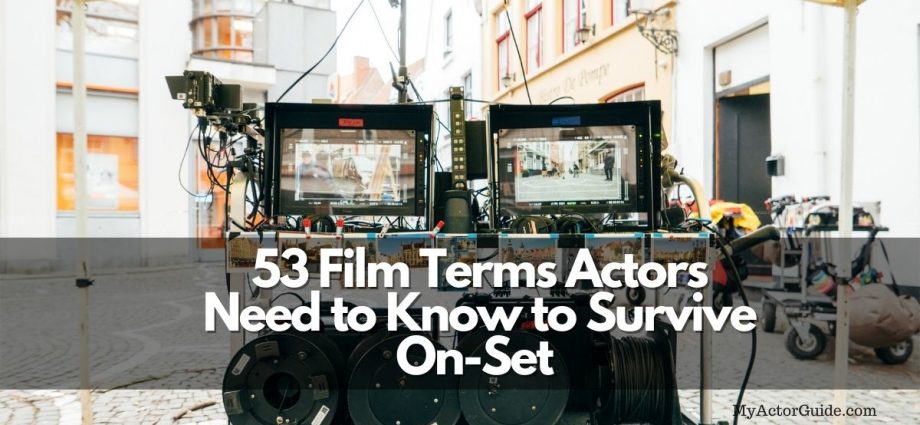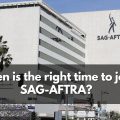This post may contain affiliate links, so I may receive a commission, at no cost to you, if you make a purchase through a link. Check out the disclosure for more info. And thank you for supporting free content!
To an outsider it may seem that actors are the centre of any film or television production. And while the on-camera talent are the ones who get most of the credit, actors are really just a small piece of the puzzle – it takes a lot of people to make a movie or a TV show! And there is a lot going on, on any set. It’s important to have a basic understanding of who else is on set (the crew), what everyone does, what things are called and where you fit in. Not knowing the basic terms can lead to some pretty big blunders! (Trust me…. I think I made them all!) When you don’t know the basics, mistakes happen and it’s just plain embarrassing. It can also cause problems and cost money.
I’ve pulled together the key terms that are most useful to newbies, and tried to organize them in a way that makes sense. Take a few minutes and familiarize yourself with these before the next time you head to set.
THE PEOPLE
Director: The director is in charge of bringing the story to life! They are usually the ones who have final say on casting, (yes, not the casting director!) and many times the crew they want to work with. They give the orders on set and keep everything moving forward and running as smoothly as possible.
Producer: The producer is the highest-ranking person on the entire production. They are the ones bringing in the finances, and ultimately responsible for the overall production. Larger productions have several producers, including an Executive Producer, Associate Producer and Line Producer.
Assistant Director or A. D. : Most sets have several A.D.’s, with the 1st AD being the one highest ranking. They are the right-hand person to the director and in-charge of managing cast and crew, including corralling extras, coordinating and writing the call sheets, may assist in setting up shots, while assisting the production manager.
D.P. – Director of Photography or Cinematographer (film) : The D.P. is super important! They are the ones who are in charge of designing and lighting the shot. These are the people who make you look good!
Production Manager: Production Managers organize the business part of the shoot including, finances. They are in charge of how the production budget is spent and making sure that everything runs smoothly during filming.
Gaffer: This is the name given to the chief lighting technician. Gaffers are in charge of the electrical department and work closely with the DP to achieve the vision they have for the shots, including the look, and feel of the that is being achieved through lighting.
Grip: Grips’ are responsible for all of the equipment. They ensure that all of the cameras, lights, etc. are properly mounted and secured with cables, pulleys, and other rigging. They work very closely with the camera department, especially if the camera is mounted on a dolly or crane, and the electrical department to put in lighting setups necessary for a shot. Grips are also responsible for safety on set as it relates to equipment.
Script Supervisor: Also called referred to as the continuity person, a script supervisor is the person who keeps track of what has been shot in accordance with the script, including what changes have been made and and to make sure there is continuity moving forward.
Craft Services: These are the nice people who feed you 🙂 They provide cast and crew with snacks, drinks and meals when appropriate. You’ll often hear them nicknamed “crafties” and like all other crew members they are repped by a union too! (IATSE)
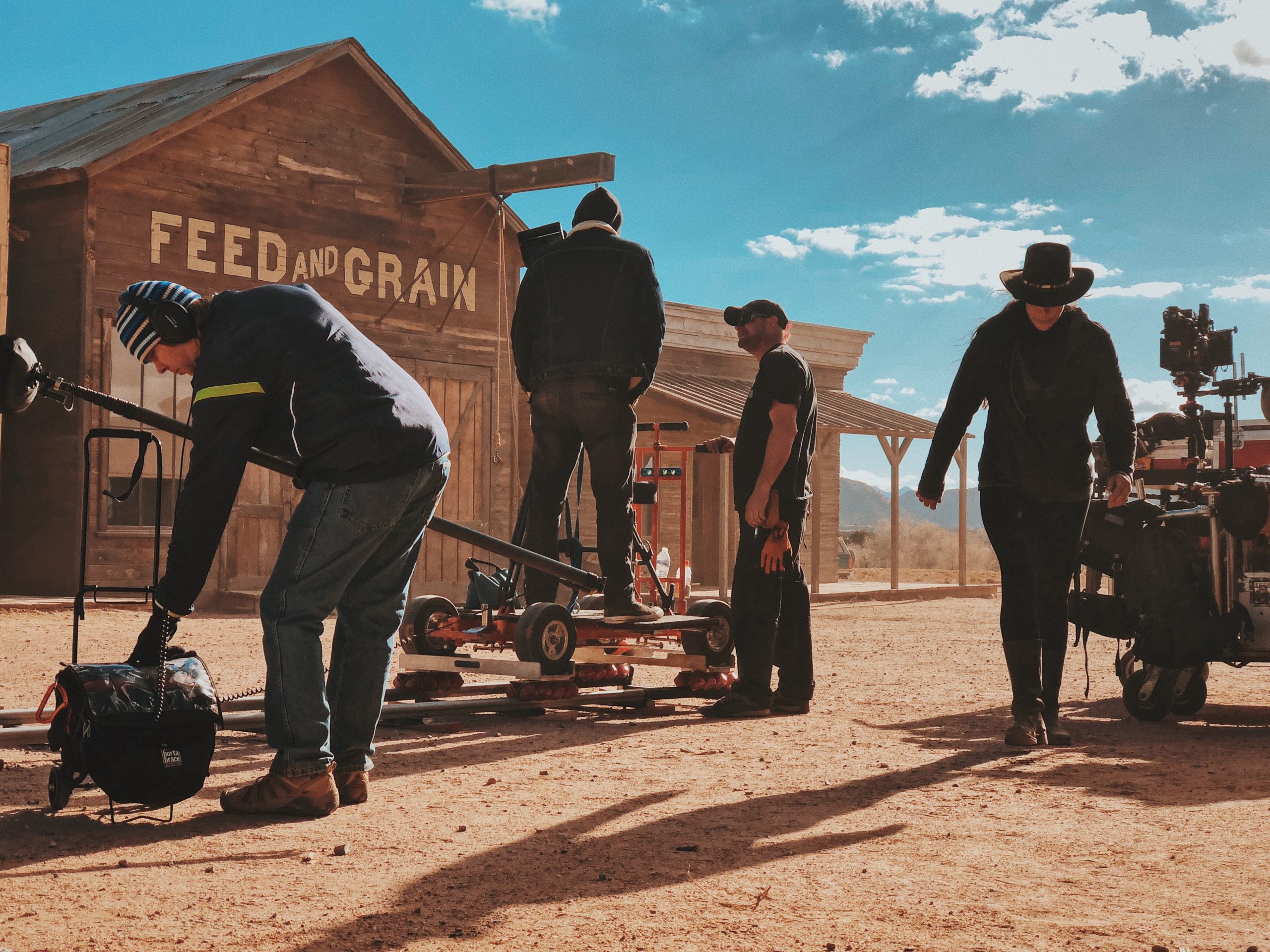
BEFORE ARRIVING
Call Sheet: A call sheet is a document sent out to the cast and crew, usually the night before, that outlines where you need to be for the following day for shooting. It also includes contact information for most people on the production, details the daily shooting schedule, shows the weather conditions for the shooting day, parking details and regulations, nearest medical center and all other specifics needed. This is your bible for the shoot days! Read it twice and keep a copy on your phone.
Call Time: Your call time is the time you, or other cast and crew members, needs to be on the set and ready to work. For actors, this does not mean ‘camera ready’, it just means being there and ready to start. The crew will have a much earlier call time than the actors because they need to get everything set-up and ready for shooting – including the hair and make-up stations! Keep in mind at the end of the day when you’re tired, that the crew has been there hours before you showed up, so be nice to them, stay out of the way and show a little extra patience.
Camera Ready: For actors, camera ready basically means to be in wardrobe with hair and make-up done. At this point, you are completely ready to appear on camera. For lower budget productions, student films and indie productions, you might be asked to turn up ‘camera ready’.
Location or On-Location: A place other than a studio or studio lot where filming is done.
Right-to-Work: The ability to accept employment without joining a labor union, usually referring to states whose labor codes insure that right.
Right-to-Work State (U.S.): In a right-to-work state, actors who have not joined a union have the right do both union and non-union work. Companies cannot refuse to hire an actor because they do not belong to a union or do not want to join a union. In a Right To Work state a NON-UNION performer CAN work Union jobs, however, a UNION performer CANNOT work Non-Union jobs. Union actors must still abide by union rules. The right-to-work states are: Alabama, Arizona, Arkansas, Florida, Georgia, Indiana, Iowa, Kansas, Louisiana, Mississippi, Nebraska, Nevada, North Carolina, North Dakota, South Carolina, Tennessee, Texas, Utah, Virginia and Wyoming.
CONTRACT TERMS
Day-Player: An actor who is hired, usually at union scale (minimum union pay) for a single day.
Forced Call: This happens when an actor or crew member is made to come back to work without the required minimum turn-around time in between shoots or work days.
Under-Five (U/5): An acting role designation calling for five lines or less on AFTRA shows. This category has a specific pay rate, which is less than a day-player.
Meal Penalty: Additional monies that must be paid to a working cast or crew member if you have not been fed after the six hours stipulated by union contracts.
On-Avail / On-Hold: Being put on hold or “check avail” happens when production wants to make sure you are available for the shoot without committing anything in writing. On one hand, it sounds great! But in reality, there will be a number of actors put “on avails” for the same part. Yes, you’re in the running, but it’s not guaranteed.
Per Diem: (Latin: “for day”) Is a daily allowance given to cast and crew for costs incurred while filming on location. This is usually for food, laundry and personal incidentals. This use to be done in cash, but is now included with your paycheck. Agents do not take a commission on your per diem.
Second Meal: The meal served six hours after the end of lunch. Under union contracts, production must provide hot food to actors every six hours or pay a financial penalty.
Turnaround: This is the cast and crew rest time from the wrap time of one day’s shoot until the call time the next day.
Union Scale: Minimum wage scale earned in employment by members of and major performers’ union including: SAG-AFTRA, ACTRA and BAFTA
Upgrade: A pay-rate increase given to a performer for an increase in lines or larger role. Often this refers to a background performer going from “extra” status to “principal” status.
Work Vouchers: The paper given to an Extra or Background Performer at the time of check-in. It must be filled out and turned in at the end of the day of shooting to receive your pay.
PLACES ON-SET
Craft Services: This is the food table area on a set, and can also be used to describe the nice people who feed you 😋 Often called “crafty” for short.
Holding Area: The designated area on set or on-location for extras to wait until they are needed. If you are told to go to holding, you are expected to stay there until you are called.
Honey Wagon: A bank of trailers / mobile units, used for dressing rooms, and on-site restrooms. Most often attached together and pulled to the shooting location by a tractor trailer.
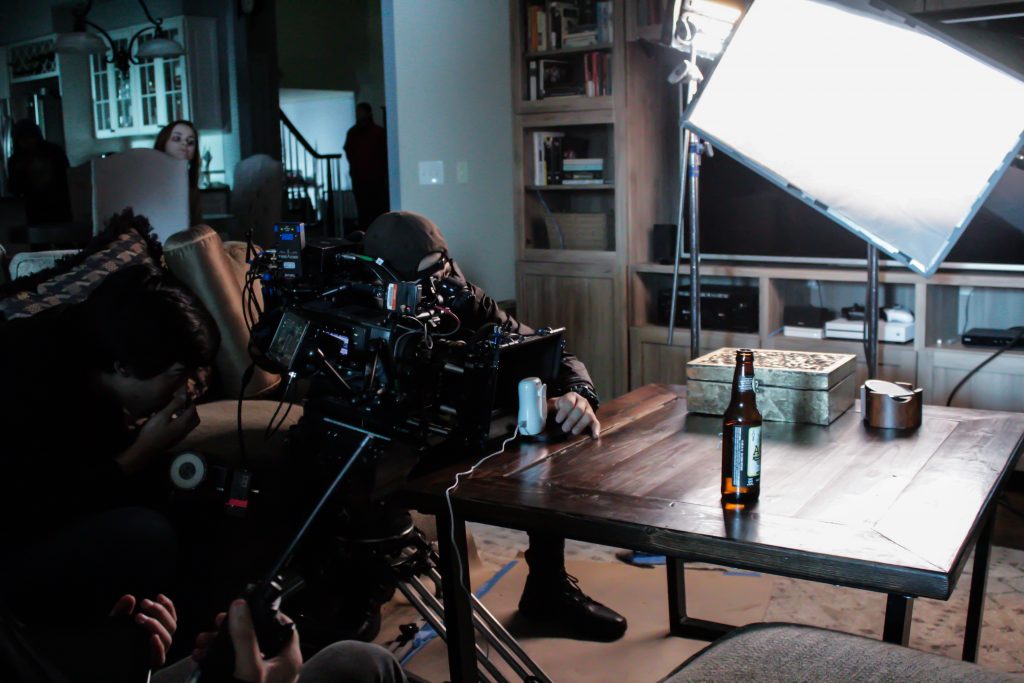
THE BASICS
Apple Boxes: These are not literally boxes that apples came in, although they would have been at one time, which is where the name came from. Apple box refers to a wooden crate that is used most often for an actor to stand on to achieve a desired height in a scene. They may also be used for props or equipment. Half height boxes are known as ‘half apples’
Boom Mic: A microphone on the end of a pole, held above actor’s heads to record dialogue.
False Start: Term used to describe a take in which the talent makes a mistake within the first couple of lines. The take is usually stopped, and a new take is slated.
Hot Set: This is a set, or part of a set, that is in active play. Shooting may be taking place on another part of the set at the moment, but will return to this spot. Everything, including all props should be treated as if on live camera – don’t touch or move anything!! (I learned this one the hard way! 😬)
In The Can: A phrase that is used when a good take is achieved and you have it locked and is considered ready for processing or “in the can.” It generally means that the director has the take they want. (Probably a throwback to when we shot on film that was actually stored in a canister)
Magic Hour: Also called the ‘golden hour’ is the period of daytime shortly after sunrise or just before sunset, during which daylight is redder and softer than when the sun is higher in the sky. DPs have referred to this as magic because of the beautiful quality of light for shooting.
MOS: Literally means “Without sound” but is attributed to a German director who pronounced it, “Mit out sound.”
Off-Camera (OC): This is usually when a character is saying lines but we are not seeing them in the shot. i.e. could be yelling from another room. It could also be a part that you are only providing the voice for.
On-Camera: Just like the name suggests, a part in a TV show, movie or video where you actually appear on screen.
Second Team: A group of stand-ins who take the primary actors’ places for purposes of lighting changes and setting up shots. The ‘second team’ will often stand in on set while the First Team of primary actors goes to hair and make-up.
Set Dressing: Can refer to items placed on-set to create ambiance and feel, or the act of preparing the set. i.e. hanging drapes would be ‘set dressing’
Slate: Slate means a few things – it’s another name for the clapper board that is used at the beginning of every shot, but it can also refer to the audible and visual announcement of the take number recorded ahead of recording each shot. The slate is used to help the production team separate the shots. (Slate is also an audition term, and is you saying your name and agency at the top of a video audition.)
Stand-in: As mentioned above, a stand-in for film and television is a person who ‘stands-in’ for the main actor while a shot is being set up, before shooting takes place. This is for technical purposes such as lighting, staging and camera setup. Stand-ins are not the same as body doubles, who replace actors on camera from behind, usually where nudity is required or during stunts. Stand-ins are paid more than a regular background performer, but less that a main actor and they do not appear on camera.
Strike: Can mean to remove something from a set, or to tear down the set, but it is also used when a production light or series of lights are turned on. While it is less common today, every now and then you might hear someone yell “striking” when turning on bright lights.
Two-Shot: A two shot is a shot in which the frame encompasses two actors. Classic two shots are shot with a medium lens, head to knees or closer.
THINGS YOU’LL HEAR
“Action!” The cue the director gives actors to begin the scene
“Back-to-Ones!” Also “Back to first!” is the direction given, usually by the Assistant Director after a take to instruct actors to go back to the position they started in at the beginning of the scene. This is very important for background performers to know!
“Checking the Gate!” The act of “checking the gate” means to check the lens area of a camera to make sure there was no hair or dust that might have interfered with the shot. This is done at the end of shooting a scene. If all is good, you move on to shooting the next scene.
“Cut!” The director’s cue to stop filming and / or stop all action.
“Fire in the Hole!” An expression used before an explosion or gunshot is about to take place
“Print!” – Director’s cue that the shot was good enough to “print” or use.
“Quiet for room tone!” Roomtone is the sound a room makes without anyone in it or with all actors standing silent. Every room, every space, has a different ambient sound. This is critical when trying to match voice parts from one session to another.
Room tone is used as a sound bed to accompany any new sound that is added to a scene in post-production. It is recorded in every room used on-set, typically, at the end of shooting a scene. When you hear “Quiet for room tone!”, stand still and don’t make a sound.
“Speed!” A exclamation that indicates the camera and the audio are running simultaneously at the correct speed. This is checked at the start of every scene and is what you’ll hear just before “Action!”
“That’s a wrap!” The end of the shooting day.
I hope you found these to be super useful! Like it, love it? Share it with an actor buddy, post it, tweet or even pin it!
Thoughts or questions? Head to the comments section below… I love to hear from you 🙂
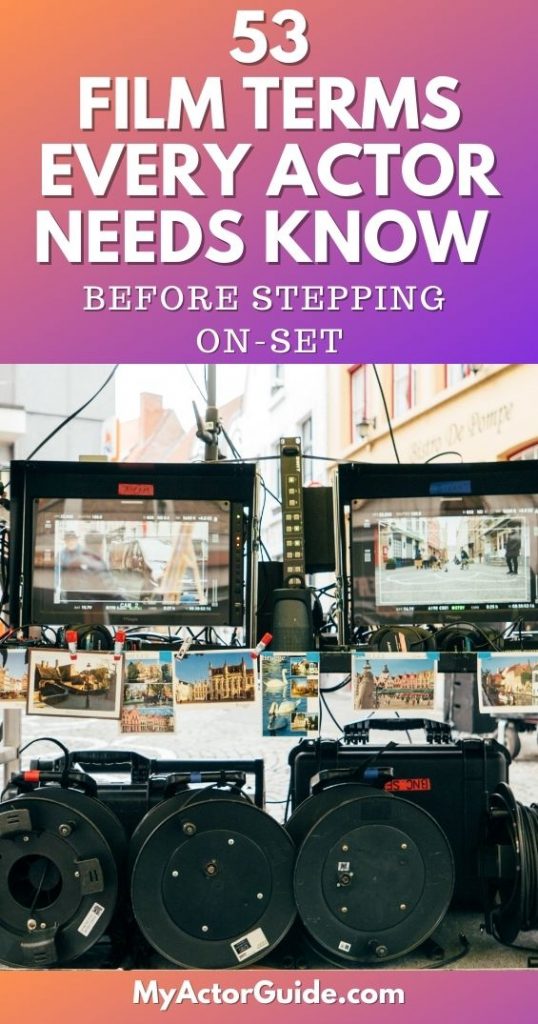
* Please Note: I am not an agent, manager, or casting director. I do not procure work for actors. All information, workshops and coaching are for educational purposes only and are not a guarantee or promise of employment. Thank you for being here!

